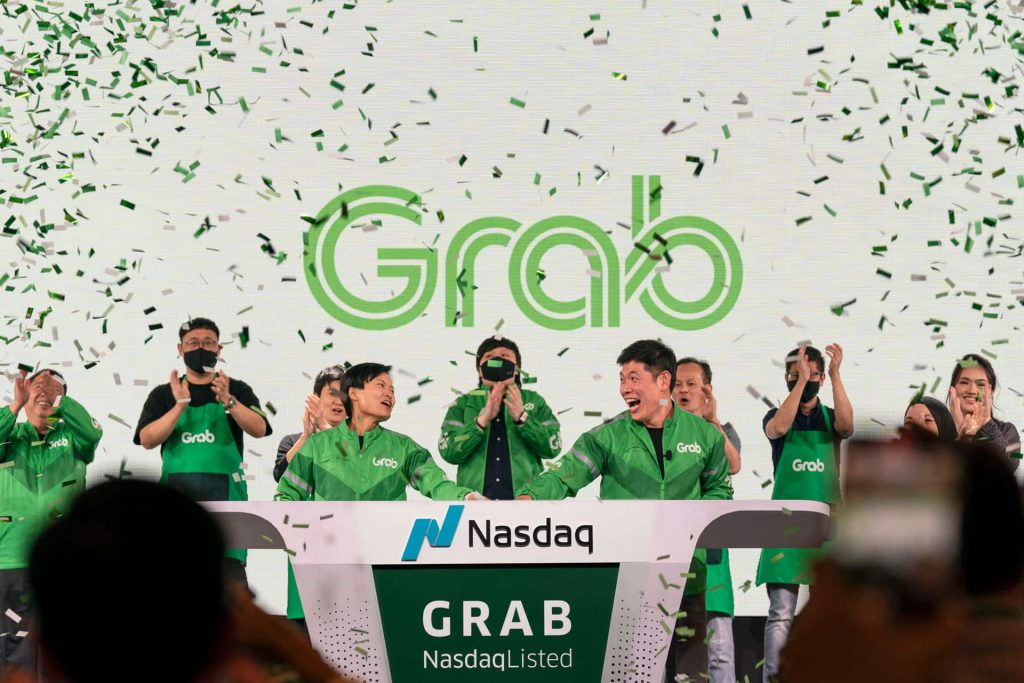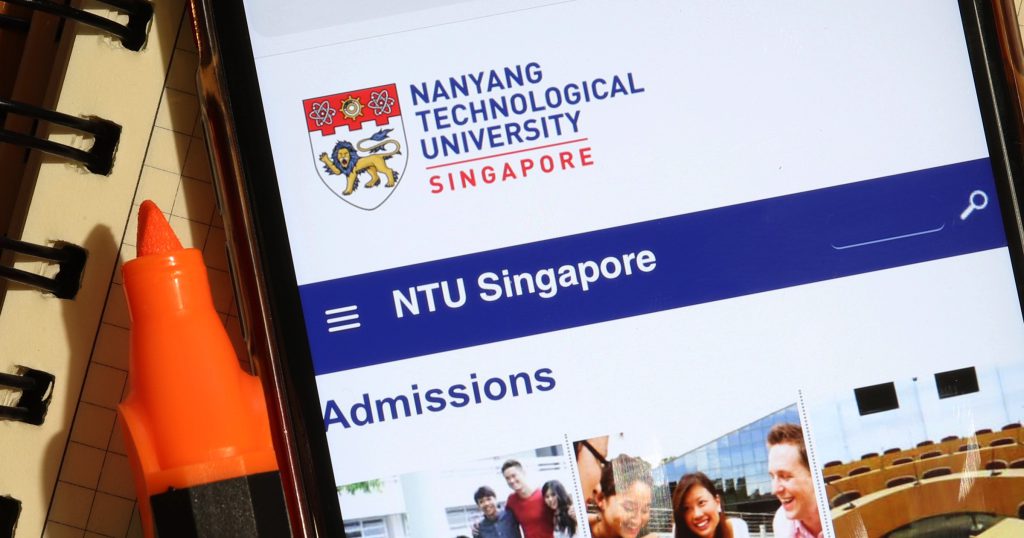Last December, investors and observers were on the edge of their seats when Singapore’s tech giant Grab finalised its public listing plans. It was the largest-ever US public market debut by a Southeast Asian company.
Through the US$54 billion initial public offering (IPO), Grab raised proceeds of US$4.5 billion. The funds will support the continued expansion of Grab’s superapp ecosystem and its mission to drive economic empowerment across Southeast Asia.
The bell ringing ceremony was held in Singapore, Nasdaq’s first such event in Southeast Asia, amid Covid times.

As of a December update, Grab operates across 465 cities in eight countries, with hyperlocal consumer services offerings such as food delivery, ride-hailing, grocery delivery, e-payments, and financial services.
What has Grab been up to since its IPO? We take a look at its latest announcements to get an idea of how it’s navigating the business.
Engaging and upskilling Grab gig workers
Grab had earlier said in media releases that for 2022, it expects to launch an initial wave of programs focused on scholarships, bursaries and disaster relief.
Current announcements have been focusing on support to its gig workers.
Last month, it announced a partnership with mental health startup Intellect and Ngee Ann Polytechnic to launch a new mental wellness programme tailored for gig workers.
Grab said it identified the increased stress workers – including gig workers – face due to rising consumer expectations and Covid-19 challenges. Through the workshops, workers can learn to better deal with their anxiety or stress more effectively.

Charles Yee, Managing Director, Operations at Grab Singapore had said that ensuring the firm’s driver- and delivery-partners’ health and well-being has always been important. “Due to their work conditions, our partners may find it challenging to access resources that can equip them with the right knowledge and know-how to look after their mental health.”
Earlier in February, Grab announced a partnership with Secura Group, a leading provider of security products and solutions in Singapore, to provide security officer training courses for Grab’s driver and delivery partners.
The training will be done through GrabAcademy, a training and career development platform aimed at strengthening and broadening the skills of partners. The platform was introduced in 2020 to help gig workers pursue new career opportunities outside of the platform.
It has since worked with several organisations including Microsoft, Ngee Ann Polytechnic, and Temasek Polytechnic to roll out workshops and development programmes to help partners secure information technology (IT)-related jobs and trainee positions.
Focusing on customer experience
Efforts to engage customers continue. Other than the soon to launch digibank GXS, the company has launched new initiatives, albeit smallish rollouts.
Earlier this year, it expanded its linked bank account feature to include more banks for GrabPay top-ups.
The integration involves six banks initially, including Bank of China, DBS, Maybank, OCBC, Standard Chartered, and UOB. Grab users in Singapore can link their local bank accounts to their Grab account via the linked bank account feature and use it to top up their GrabPay wallet at zero cost.

Other banks like Citibank, HSBC, and ICBC will be added to the app progressively.
The feature, enabled by Electronic GIRO (eGIRO), allows users to top up their GrabPay wallets promptly without leaving the Grab app. Unlike credit card top-ups, there are no extra fees incurred for topping up using this feature on the Grab app and users will only need to link their bank account once.
As funds are fully transferable, users can also choose to transfer funds back to their own bank accounts, or make transfers to other bank accounts or e-wallets.
Grab is also working on partnering with major food and beverage companies to provide enhanced in-app experiences.
Last month, Starbucks announced an integrated partnership with Grab across six markets, including the Philippines, Thailand, Singapore, Malaysia, Indonesia, and Vietnam.
The partnership will provide customers across Southeast Asia with a seamless Starbucks Experience, allowing them to earn Starbucks Rewards benefits on purchases through Grab, have more ways to order and pay in stores, and enjoy their Starbucks orders sooner with last-mile delivery fulfillment through Grab’s delivery network.
Saad Ahmed, Managing Director, Commercial at Grab commented: “We believe the online ordering and in-store dining experience will become more connected, as brands in Southeast Asia look for ways to bridge these channels.”
Both Starbucks and Grab are working on enhancing the customer experience, such as allowing users the option to sign up for a Starbucks Rewards membership via the Grab app and redeem free beverages, birthday treats, and exclusive offers.
The companies plan to introduce the new feature in the Philippines in the second half of 2022, with plans to expand to additional Southeast Asia markets by 2024.
Building its superapp
To be a superapp, it has to be a one-stop solution for customers’ daily needs, and that includes providing access to grocery shopping.
Grab has shown that it has a keen interest in the grocery delivery space, as seen by it buying a majority stake in Jaya Grocer, a leading mass-premium supermarket chain in Malaysia in January this year.
The two companies plan to work together to bring the convenience of on-demand grocery delivery to more consumers in Malaysia. Grab and Jaya Grocer have announced the rollout of GrabPay and GrabRewards across all Jaya Grocer physical retail stores, expanding the usage of Grab’s cashless wallet.

“The acquisition comes at a time of accelerated growth in on-demand grocery delivery services,” Grab had said in the announcement.
“Prolonged movement restrictions and consumer concerns about safety and hygiene have led to a boom in adoption of online grocery shopping. 64 per cent of Southeast Asia’s internet users purchased groceries online at least once during the pandemic, yet online grocery transactions only accounted for approximately two per cent of the total grocery spend,” the tech giant added.
Online grocery demand remained elevated even as restrictions eased, the company noted. GrabMart, Grab’s on-demand grocery and specialty retail marketplace, recorded three straight quarters of growth in the first three quarters of 2021.
The move is aligned with Grab’s plans to double down on on-demand grocery delivery. The company is scaling its GrabMart marketplace by partnering with retailers to provide consumers with greater product variety and convenience.
A Bloomberg article in March also noted that Grab has been vying for consumer lender Home Credit’s US$2 billion assets, citing sources. Home Credit’s operations are in nine countries across Asia and Europe. It allows users to do online and offline transactions, and pay in installments.
The interest to purchase such an entity may be for Grab to beef up its financial services segment, which is set to become one of the firm’s focus this year amid its digibank rollout.
Road to profitability, soon?
Grab’s revenue had slumped 44 per cent to US$122 million in the fourth quarter of 2021 due to a downturn in its mobility and enterprise and new initiatives segments.
Although currently the superapp is keeping mum about its digibank developments, we note that it has been quietly offering business loans and cash advances to SMEs. There are plans for GXS to roll out soon this year.
Maybank analysts are expecting Grab to break even by 2025. That’s despite its poor performance on the stock market since its listing in December. The bank has set a target price of US$4.32 over the next 12 months, which is a 25 per cent upside from the current trading price of around US$3.45 per share.

“If Grab is able to markedly reduce excess partner and consumer incentives without sacrificing gross merchandise value growth, we see the possibility of Grab becoming profitable earlier than 2025,” said Maybank analysts Lai Gene Lih and Samuel Tan.
The analysts said Grab’s market leadership across several of its business segments in South-east Asia, its ability to attract and maintain consumers and partners, and its established brand presence in the region, are its selling points.
The analysts also identified Grab’s financial services portion as a key growth segment and that it has an advantage over current financial services incumbents in reaching the vast underbanked population in Southeast Asia.
But risks remain for Grab as it grows larger. For one, pouring resources into its financial services segment would mean tighter cash flow for the firm.
Regulatory changes on gig workers, for example reclassifying gig workers as employees with the requirement to provide them pension (or in Singapore’s case Central Provident Fund or CPF contributions), could also add to higher business costs.
Featured Image Credit: Grab










